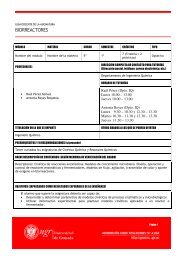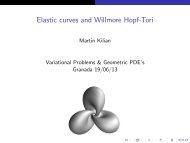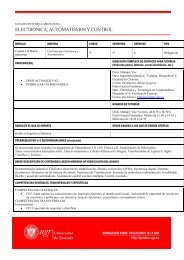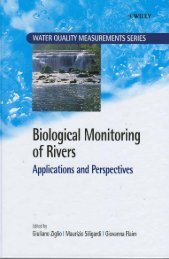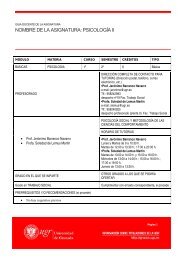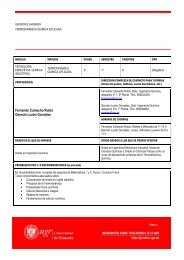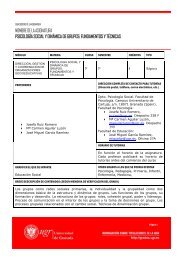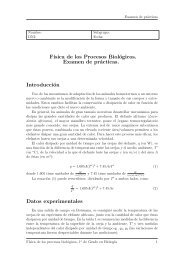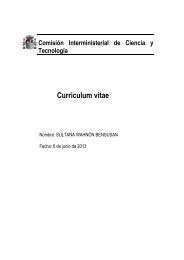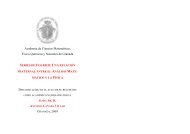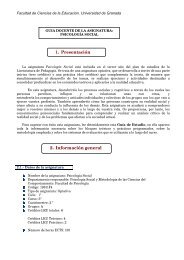ON GLOBAL RIEMANN-CARTAN GEOMETRY
ON GLOBAL RIEMANN-CARTAN GEOMETRY
ON GLOBAL RIEMANN-CARTAN GEOMETRY
You also want an ePaper? Increase the reach of your titles
YUMPU automatically turns print PDFs into web optimized ePapers that Google loves.
<strong>ON</strong> <strong>GLOBAL</strong> <strong>RIEMANN</strong>-<strong>CARTAN</strong> <strong>GEOMETRY</strong><br />
Prof. Sergey E. Stepanov<br />
Finance University<br />
under the<br />
Government of Russian Federation<br />
Moscow (Russia)<br />
E-mail: s.e.stepanov@mail.ru<br />
1
1. History of the Metrically-Affine Theory<br />
The beginning of metrically-affine space (manifold) theory was marked by E. Cartan in 1923-1925, who suggested<br />
using an asymmetric linear connection ∇ having the metric property ∇ g = 0<br />
theory of gravity (ECT).<br />
. His theory was called Einstein-Cartan<br />
[1] Cartan Е. Sur les variétés à connexion affine et la théorie de la relativité généralisée. Part I, Ann. Ec. Norm., 40<br />
(1923), 325-412.<br />
[2] Cartan Е. Sur les variétés à connexion affine et la théorie de la relativité généralisée. Part I, Ann. Ec. Norm., 41<br />
(1924), 1-25.<br />
[3] Cartan Е. Sur les variétés à connexion affine et la théorie de la relativité généralisée. Part II, Ann. Ec. Norm., 42<br />
(1925), 17-88.<br />
[4] Cartan E. On manifolds with an affine connection and the theory of general relativity. Napoli: Bibliopolis, 1986, 199<br />
p.<br />
[5] Trautman A. The Einstein-Cartan theory. Encyclopedia of Mathematical Physics: Edited by Fracoise J.-P., Naber<br />
G.L., Tsou S.T. – Oxford: Elsevier, 2 (2006), 189-195.<br />
2
T. Kibble and D. Sciama have found a connection between the torsion S of the connection ∇ and the spin tensor s<br />
of matter. Subsequently, other physical applications of ECT were found.<br />
[6] Kibble T.W.B. Lorenz invariance and the gravitational field. J. Math. Phys, 2 (1961), 212-221.<br />
[7] Sciama D.W. On the analogy between change and spin in general relativity. Recent developments in General<br />
Relativity. – Oxford: Pergamon Press & Warszawa: PWN, 1962, pp. 415-439.<br />
[8] Penrose R. Spinors and torsion in General Relativity. Found. of Phys 13 (1983), 325-339.<br />
[9] Ruggiero M.L., Tartaglia A. Einstein-Cartan theory as a theory of defects in space-time. Amer. J. Phys. 71 (2003),<br />
1303-1313.<br />
The Einstein-Cartan theory was generalized by omitting the metric property of the linear connection ∇, i.e. the<br />
nonmetricity tensor Q = ∇g<br />
≠ 0 . The new theory was called the metrically-affine gauge theory of gravity (MAG).<br />
[10] Hehl F.W., Heyde P. On a New Metric-Affine Theory of Gravitation. Physics Letters B. 63: 4 (1976), 446-448.<br />
3
The E. Cartan idea was reflected in the well-known books in differential geometry of the first half of the last century.<br />
Now there are hundreds works published in the frameworks of ECT and MAG, and moreover, the published results<br />
are of applied physical character.<br />
[11] Schouten J.A., Struik D.J. Einführung in die neuere methoden der differntialgeometrie, I. Noordhoff: Groningen-<br />
Batavia, 1935.<br />
[12] Schouten J.A., Struik D.J. Einführung in die neuere methoden der differntialgeometrie, II. Noordhoff: Groningen-<br />
Batavia, 1938.<br />
[13] Eisenhart L.P. Non Riemannian geometry. New York: Amer. Math. Soc. Coll. Publ., 1927.<br />
[14] Eisenhart L.P. Continuous groups of transformations. Prinseton: Prinseton Univ. Press, 1933.<br />
[15] Puetzfeld D. Prospects of non-Riemannian cosmology. Proceeding of the of 22 nd Texas Symposium on<br />
Relativistic Astrophysics at Stanford University (Dec. 13-17, 2004). California: Stanford Univ. Press, 2004, 1-5.<br />
[16] Hehl F.W., Heyde P., Kerlick G.D., Nester J.M. General Relativity with spin and torsion: Foundations and<br />
prospects. Rev. Mod. Phys, 48: 3 (1976), 393-416.<br />
4
Classification of known kinds of metrically-affine spaces (manifolds) is presented in the following diagram.<br />
Metric-affine<br />
Metric-affine<br />
manifolds<br />
manifolds<br />
Q = n -1 tr Q g<br />
Weyl-Cartan<br />
Weyl-Cartan<br />
= 0 manifolds<br />
manifolds<br />
Q = 0<br />
Weyl<br />
Weyl<br />
manifolds<br />
manifolds<br />
Q = 0<br />
= 0 Q = 0<br />
Riemannian<br />
Riemannian<br />
manifolds<br />
manifolds<br />
= 0<br />
Flat<br />
Flat<br />
manifolds<br />
manifolds<br />
Riemannian<br />
Riemannian<br />
–<br />
–<br />
Cartan<br />
Cartan<br />
manifolds<br />
manifolds<br />
manifolds<br />
manifolds<br />
= 0 = 0<br />
= 0<br />
Weitzenböck<br />
Weitzenböck<br />
manifolds<br />
manifolds<br />
5
For long time, among all forms metrically-affine space, only quarter-symmetric metric spaces and the semisymmetric<br />
metric spaces were considered in differential geometry.<br />
[17] Yano K. On semi-symmetric metric connection. Rev. Roum. Math. Pure Appl., 15 (1970), 1579-1586.<br />
[18] Nakao Z. Submanifolds of a Riemannian manifold semi-symmetric metric connections. Proc. Amer. Math. Soc.,<br />
54 (1976), P. 261-266.<br />
[19] Barua B., Ray A.K. Some properties of semi-symmetric connection in Riemannian manifold. Ind. J. Pure Appl.<br />
Math., 16 (1985), No. 7, 726-740.<br />
[20] Chaubey S.K., Ojha R.H. On semi-symmetric non-metric and quarter symmetric metric connections. Tensor,<br />
N.S., 70 (2008), 202-213.<br />
[21] Segupta J., De U.C., Binh T.Q. On a type of semi-symmetric connection on a Riemannian manifold. Ind. J. Pure<br />
Appl. Math., 31: 12 (2000), 1650-1670.<br />
[22] Muniraja G. Manifolds admitting a semi-symmetric metric connection and a generalization of Shur’s theorem. Int.<br />
J. Contemp. Math. Sciences, 3: 25 (2008), 1223-1232.<br />
6
The development of geometry of metrically-affine spaces “in the large” was stopped at the results of K. Yano, S.<br />
Bochner and S. Goldberg obtained in the middle of the last century. In their works, in the frameworks of RCT, they<br />
proved “vanishing theorems” for pseudo-Killing and pseudo-harmonic vector fields and tensors on compact Riemann-<br />
Cartan manifolds with positive-definite metric tensor g and the torsion tensor S such that trace S = 0.<br />
Y. Kubo, N. Rani and N. Prakash have generalized their results by introducing in consideration compact Riemann-<br />
Cartan manifolds with boundary.<br />
[23] Bochner S., Yano K. Tensor-fields in non-symmetric connections. The Annals of Mathematics, 2 nd Ser. 56: 3<br />
(1952), 504-519.<br />
[24] Yano K., Bochner S. Curvature and Betti number. Princeton: Princeton University Press, 1953.<br />
[25] Goldberg S.I. On pseudo-harmonic and pseudo-Killing vector in metric manifolds with torsion. The Annals of<br />
Mathematics, 2 nd Ser. 64: 2 (1956), 364-373.<br />
[26] Kubo Y. Vector fields in a metric manifold with torsion and boundary. Kodai Math. Sem. Rep. 24 (1972), 383-395.<br />
[27] Rani N., Prakash N. Non-existence of pseudo-harmonic and pseudo-Killing vector and tensor fields in compact<br />
orientable generalized Riemannian space (metric manifold with torsion) with boundary. Proc. Natl. Inst. Sci. India.<br />
32: 1 (1966), 23-33.<br />
7
2. Riemann-Cartan manifolds<br />
A Riemann-Cartan manifold is a triple ( M ,g,∇)<br />
, where ( M ,g ) is a Riemannian n-dimensional ( n ≥ 2)<br />
manifold with<br />
linear connection ∇ having nonzero torsion S such that ∇g = 0 .<br />
[1] Trautman A. The Einstein-Cartan theory. Encyclopedia of Mathematical Physics: Edited by Fracoise J.-P., Naber<br />
G.L., Tsou S.T. – Oxford: Elsevier, 2 (2006), 189-195.<br />
The deformation tensor T defined by the identity<br />
following properties<br />
(i)<br />
T is uniquely defined;<br />
(ii) S ( X, Y ) ( T ( X,<br />
Y ) −T<br />
( Y,<br />
X ))<br />
;<br />
(iii)<br />
= 2<br />
1<br />
g ( T ( X ,Y ),Z<br />
) + g ( T ( X ,Z ),<br />
Y ) = 0<br />
2<br />
T ∈C<br />
∞ TM ⊗Λ M since ∇ = 0 ⇔ g ;<br />
(iV) g ( T ( Y ,Z ),<br />
X ) g ( S( X ,Y ),Z<br />
) + g ( S( X ,Z ),Y<br />
) + g( S( Y ,Z ),<br />
X )<br />
(V) trace T = 2 trace S .<br />
= ;<br />
Т := ∇ −∇<br />
where ∇ is the Levi-Civita connection on (M, g) has the<br />
[2] Yano K., Bochner S. Curvature and Betti number. Princeton: Princeton University Press, 1953.<br />
8<br />
3. Cappozziello-Lambiase-Stornaiolo classification of Riemann-Cartan manifolds
We know that<br />
S<br />
b<br />
∈C<br />
∞ Λ<br />
2 M ⊗TM<br />
( M ) ⊕ Ω ( M ) ⊕ ( M )<br />
∗<br />
M ⊗ T M ≅ Ω<br />
2<br />
3<br />
Λ 2 Ω<br />
1<br />
. In turn, the following pointwise O(q)-irreducible decomposition holds<br />
. Here, q = g(x) for an arbitrary point x ∈ M<br />
projections on the components of this decomposition are defined by the following relations:<br />
(1)<br />
S<br />
b<br />
( )<br />
b<br />
b<br />
b<br />
( X , Y,<br />
Z ) = −1 S ( X,<br />
Y,<br />
Z ) + S ( Y,<br />
Z,<br />
X ) + S ( Z,<br />
X,<br />
Y )<br />
3 ;<br />
( X,<br />
Y,<br />
Z ) g( Y,<br />
Z ) θ ( X ) g( X,<br />
Z ) θ( Y )<br />
(2) S b<br />
−<br />
(3)<br />
S<br />
b<br />
= ;<br />
( )<br />
b<br />
(1) b<br />
(2) b<br />
( X , Y,<br />
Z ) S ( X,<br />
Y,<br />
Z ) − S ( X,<br />
Y,<br />
Z ) − S ( Z,<br />
X,<br />
Y )<br />
= ,<br />
b<br />
where S ( X,<br />
Y,<br />
Z ) = g( S( X,<br />
Y ),<br />
Z ) and := ( n −1) −1 trace S<br />
θ .<br />
. In this case, the orthogonal<br />
[1] Bourguignon J.P. Formules de Weitzenbök en dimension 4. Géométrie Riemannienne en dimension 4: Seminaire<br />
Arthur Besse 1978/79. – Paris: Cedic-Fernand Nathan, 1981.<br />
We say that a Riemann-Cartan manifold ( M ,g,∇)<br />
belongs to the class Ω<br />
α or<br />
the tensor field<br />
b<br />
S is a section of corresponding tensor bundle α<br />
( Ě )<br />
Ω or ( Ě ) ⊕ Ω ( Ě )<br />
Ωα<br />
⊕ Ω<br />
β for α , β = 1 , 2,<br />
3 and α < β if<br />
Ω .<br />
α<br />
β<br />
[2] Capozziello S., Lambiase G., Stornaiolo C. Geometric classification of the torsion tensor in space-time. Annalen<br />
Phys., 10 (2001), 713-727.<br />
9
All these classes of Riemann-Cartan manifolds are presented in the following diagram.<br />
Riemannian<br />
Riemannian<br />
-<br />
-<br />
-<br />
-<br />
Cartan<br />
Cartan<br />
manifolds<br />
manifolds<br />
Ω 1 ⊕<br />
Ω<br />
1 ⊕ 2 2<br />
Ω 1<br />
Ω 2<br />
Ω 1<br />
Ω 1 ⊕<br />
Ω<br />
1 ⊕ 3<br />
Ω 2<br />
3<br />
Ω 2 ⊕<br />
Ω<br />
2 ⊕ 3<br />
Ω<br />
3<br />
3 3<br />
Riemannian<br />
Riemannian<br />
manifolds<br />
manifolds<br />
10
4. The class Ω 1 ⊕ Ω 2 of Cappozziello-Lambiase-Stornaiolo classification<br />
Lemma 4.1. A Riemann-Cartan manifold ( ,∇)<br />
satisfies an algebraic equation of the form<br />
b<br />
of Riemann-Cartan manifolds<br />
M,g belongs to the class Ω1 ⊕ Ω<br />
2 if and only if its torsion tensor<br />
b<br />
( X,<br />
Y,<br />
Z ) + S ( X,<br />
Z,<br />
Y ) = g( X,<br />
Z ) B( Y ) + g( X,<br />
Y ) B( Z ) + g( Y Z ) A( X )<br />
S ,<br />
for some smooth A, B ∈ С<br />
∞ Т<br />
∗ М and arbitrary vector fields X, Y, Z ∈С ∞ ТМ<br />
Lemma 4.2. The class Ω 2 of Riemann-Cartan manifolds ( M,g ,∇)<br />
consists of semisymmetric Riemannian-Cartan<br />
manifolds.<br />
Lemma 4.3. A Riemann-Cartan manifold ( M,g ,∇)<br />
belongs to the class Ω 1 if and only if its torsion tensor satisfies the<br />
property<br />
S<br />
b<br />
∈C<br />
∞ Λ<br />
3<br />
M<br />
. In particular, this class includes spaces of semisimple groups.<br />
[1] Eisenhart L.P. Continuous groups of transformations. Princeton: Princeton Univ. Press, 1933.<br />
[2] Yano K., Bochner S. Curvature and Betti number. Princeton: Princeton University Press, 1953.<br />
[3] Fabri L. On a completely antisymmetric Cartan torsion tensor. Annalen de la Foundation de Broglie 32: 2-3 (2007),<br />
215-228..<br />
11
We know that<br />
5. Vanhecke-Tricerri classification of Riemann-Cartan manifolds<br />
Ň<br />
b<br />
∈ŇĚ<br />
⊗C<br />
∞<br />
2<br />
Λ M<br />
. In turn, the following pointwise O(q)-irreducible decomposition holds<br />
T*M ⊗ Λ 2 M ≅ Ψ 1 (M) ⊕ Ψ 2 (M) ⊕ Ψ 3 (M). In this case, the orthogonal projections on the components of this<br />
decomposition are defined by the following relations:<br />
(1)<br />
Т<br />
Т<br />
b<br />
( )<br />
1 b<br />
b<br />
b<br />
( X ,Y ,Z ) 3 Т ( X ,Y ,Z ) + Т ( Y ,Z, X ) + Т ( Z, X ,Y )<br />
= − ;<br />
( X ,Y ,Z ) = g( X ,Z ) ω( Y ) − g( X ,Y ) ω( Z )<br />
(2) b<br />
;<br />
(3)<br />
Т<br />
b<br />
( )<br />
b<br />
(1) b<br />
(2) b<br />
( X ,Y ,Z ) Т ( X ,Y ,Z ) − Т ( Y ,Z, X ) − Т ( Z, X ,Y )<br />
= ,<br />
b<br />
−1<br />
where Т ( X,<br />
Y,<br />
Z ) = g( T ( X,<br />
Y ),<br />
Z ) and : = ( n −1) trace Т<br />
ω .<br />
[1] Bourguignon J.P. Formules de Weitzenbök en dimension 4. Géométrie Riemannienne en dimension 4: Seminaire<br />
Arthur Besse 1978/79. Paris: Cedic-Fernand Nathan, 1981.<br />
We say that a Riemann-Cartan manifold ( M ,g,∇)<br />
belongs to the class Ψ α or<br />
b<br />
tensor field Т is a section of corresponding tensor bundle Ψ α ( М ) or α ( М ) ⊕Ψβ<br />
( М )<br />
Ψ ⊕Ψ<br />
for , β = 1 , 2,<br />
3<br />
α<br />
Ψ .<br />
β<br />
α and α < β if the<br />
[2] Tricerri F., Vanhecke L. Homogeneous structures. Progress in mathematics (Differential geometry), 32 (1983),<br />
234-246.<br />
The spaces<br />
12<br />
∗<br />
Λ 2 М ⊗Т<br />
М and Т М ⊗Λ М<br />
∗<br />
2<br />
, as well as their irreducible components, are isomorphic. Therefore these<br />
two classifications are equivalent. Moreover, corresponding classes of Riemann-Cartan manifolds from these two<br />
classifications coincide.
6. Examples of Riemann-Cartan manifolds<br />
Consider a Euclidian sphere S 2 = {S 2 \ north pole} of radius R excluding the north pole and with the standard<br />
Riemannian metric g 11 = R 2 cos 2 ϕ, g 22 = R 2 , g 12 = g 21 = 0 where<br />
1 2<br />
х =ϑ , х = ϕ for denote the standard spherical<br />
coordinates of S 2 . Then X 1 = {(R cos ϕ) -1 , 0}, X 2 = {0, R -1 } are vectors of standard orthogonal basis of all vector fields<br />
on S 2 .<br />
There is a non-symmetric metric connection ∇ with coefficients<br />
1<br />
Γ - tanϕ<br />
and other Γ α β = γ 0 such that ∇ = 0<br />
where α , β,<br />
γ =1,<br />
2.<br />
For this connection ∇ the curvature tensor R = 0 and the torsion tensor S has components<br />
( ) 1 tanϕ<br />
1<br />
12 = 2 −<br />
2<br />
12 =<br />
S , 0<br />
21 =<br />
Х Х α β<br />
S . Therefore, S 2 with g and ∇ is an example of a Riemann-Cartan manifold manifold ( g,∇)<br />
In addition if R = 0 then ∇ has name Weitzenböck or a teleparallel connection.<br />
M, .<br />
[1] Cartan Е. Sur les variétés à connexion affine et la théorie de la relativité généralisée. Part I, Ann. Ec. Norm., 41<br />
(1924), 1-25.<br />
[2] Aldrovandi R., Pereira J. G., and Vu K. H. Selected topics in teleparallel gravity. Вrazilian Journal of Physics, 34:<br />
4A (2004), 1374-1380.<br />
[3] Wu Y.L., Lee X.J. Five-dimensional Kaluza-Klein theory in Weizenböck space. Phys. Letters A, 165 (1992), 303-<br />
306.<br />
13
A homogeneous Riemannian manifold (M, g) is the connected Riemannian manifold (M, g) whose isometry group is<br />
transitive.<br />
By the Tricerri and Vanhecke theorem, a complete connected Riemannian manifold (M, g) is<br />
2<br />
homogeneous iff a tensor field T ∈С<br />
∞ ТМ ⊗Λ М such that = 0<br />
∇R and = 0<br />
∇T for the connection = ∇ + T<br />
∇ .<br />
In this case, ∇g = 0 and, therefore, a homogeneous Riemannian manifold is an example of the Riemannian-Cartan<br />
manifold( M, g,∇)<br />
.<br />
[4] Tricerri F., Vanhecke L. Homogeneous structures on Riemannian manifolds. London Math. Soc.: Lecture Note<br />
Series., Vol. 83. Cambridge University Press, London, 1983.<br />
An almost Hermitian manifold is defined as the triple (M, g, J), where the pair (M, g) is a Riemannian 2m-dimensional<br />
manifold with almost complex structure J<br />
[5] Kobayshi S., Nomizu K. Foundations of Riemannian geometry, Vol. 2. Interscience publishers, New York-London,<br />
1969.<br />
∗<br />
∈ ТМ ⊗Т<br />
М compatible with the metric g, i.e. J 2 −Id<br />
TM<br />
= and g ( J, J) = g . In<br />
this case, ∇g = 0 for the connection∇<br />
=∇+∇J<br />
, and, therefore, an almost Hermitian manifold (M, g, J), together with<br />
the connection<br />
,<br />
∇ =∇+∇J<br />
, is an example of the Riemannian-Cartan manifold (M, g,∇).<br />
14
The classification of almost Hermitian manifolds is well known, it is based on the pointwise U(m)-irreducible<br />
decomposition of the tensor<br />
∇ Ω, where Ω (X, Y) = g(X, JY).<br />
Almost semi-Kählerian manifolds are isolated by the condition trace ∇ J = 0 and are an example of Riemann-<br />
Cartan manifolds of class Ω 1 ⊕ Ω 2 .<br />
Almost Kählerian manifolds are isolated by the condition dΩ = 0 and are an example of Riemann-Cartan manifolds<br />
of class Ω 2 ⊕ Ω 3 .<br />
Nearly Kählerian manifolds are isolated by the condition dΩ = 3 ∇Ω and are an example of Riemann-Cartan<br />
manifolds of class Ω<br />
1 .<br />
[6] Gray A., Hervella L. The sixteen class of almost Hermitean manifolds. Ann. Math. Pura Appl., 123 (1980), 35-58.<br />
15
7. Weitzenböck manifolds<br />
A Riemann-Cartan manifold ( M ,g,∇)<br />
is called the Weitzenböck or teleparallel manifold if the curvature tensor R of<br />
the nonsymmetric metric-affine connection ∇ vanishes.<br />
[1] Hayashi K., Shirafuji T. New general relativity. Phys. Rev. D, 19 (1979), 3524-3553.<br />
[2] Wu Y.L., Lee X.J. Five-dimensional Kaluza-Klein theory in Weizenböck space. Phys. Letters A, 165 (1992), 303-<br />
306.<br />
[3] Aldrovandi R., Pereira J.G., Vu K.H. Selected topics in teleparallel gravity. Brazilian J. Ph., 34 (2004), 1374-1380.<br />
Lemma 7.1. If the Weitzenböck manifold ( M ,g,∇)<br />
with positive-definite metric g belongs to the class Ω 1 then<br />
n<br />
( X,X ) T ( X,e ,e ) T ( X,e , e ) ≥ 0<br />
Ric = ∑ i j<br />
i j for Ricci tensor Ric of the Riemannian manifold (M, g) and an arbitrary orthonormal<br />
i,j = 1<br />
basis {e 1 , e 2 , … , e n }.<br />
Lemma 7.2. If the Weitzenböck manifold ( M ,g,∇)<br />
belongs to the class Ω 2 then the Weyl tensor W of the<br />
Riemannian manifold (M, g) vanishes and (M, g) for n ≥ 4 is a conformally flat.<br />
Lemma 7.3. If the Weitzenböck manifold ( M ,g,∇)<br />
belongs to the class Ω 3 then s = – 2<br />
2<br />
S ≤ 0 for the scalar<br />
curvature s of the Riemannian manifold (M, g).<br />
16
8. Green theorem for a Riemann-Cartan manifold<br />
∫<br />
=<br />
Let (M, g) be a compact oriented Riemannian manifold then the classical Green’s theorem ( div X ) dV<br />
0 has the<br />
∫<br />
=<br />
form ( trace∇X<br />
) d V 0 for an arbitrary smooth vector field X and the volume element dV.<br />
М<br />
М<br />
[1] Yano K., Bochner S. Curvature and Betti number. Princeton: Princeton University Press, 1953.<br />
Since the dependence<br />
∇ = ∇ + Т holds on ( ,g,∇)<br />
M , it follows that trace ∇ X = trace∇X<br />
+2( trace S)X<br />
. Whence, by the<br />
Green’s theorem, we deduce the Green’s theorem ( trace ∇X<br />
−2( traceS ) X ) d V 0 for a Riemann-Cartan manifold<br />
( M ,g,∇)<br />
.<br />
∫ =<br />
M<br />
Goldberg S., Yano K. and Bochner S. and also Kubo Y., Rani N, and Prakash N. proved their “vanishing theorems”<br />
on compact oriented Riemann-Cartan manifolds under the condition that<br />
∫<br />
trace V = 0<br />
theorem has the form ( ∇X<br />
)<br />
М<br />
div X = trace∇X<br />
. In this case Green’s<br />
d . These Riemann-Cartan manifolds belong to the class Ω 1 ⊕ Ω 3 .<br />
17
[2] Bochner S., Yano K. Tensor-fields in non-symmetric connections. The Annals of Mathematics, 2 nd Ser. 56(1952),<br />
No. 3, 504-519.<br />
[3] Yano K., Bochner S. Curvature and Betti number. Princeton: Princeton University Press, 1953.<br />
[4] Goldberg S.I. On pseudo-harmonic and pseudo-Killing vector in metric manifolds with torsion. The Annals of<br />
Mathematics, 2 nd Ser. 64 (1956), No. 2, 364-373.<br />
[5] Kubo Y. Vector fields in a metric manifold with torsion and boundary. Kodai Math. Sem. Rep. 24 (1972), 383-395.<br />
[6] Rani N., Prakash N. Non-existence of pseudo-harmonic and pseudo-Killing vector and tensor fields in compact<br />
orientable generalized Riemannian space (metric manifold with torsion) with boundary. Proc. Natl. Inst. Sci. India.<br />
32 (1966), No. 1, 23-33.<br />
18
9. Scalar and complete scalar curvature<br />
of Riemann-Cartan manifolds<br />
It is well known that the curvature tensor R of the linear non-symmetric connection ∇ of a Riemann-Cartan<br />
manifold ( ,g,∇)<br />
2<br />
2<br />
M is a section of the tensor bundle Λ M ⊗ Λ M . Therefore the scalar curvature of the Riemann-<br />
Cartan manifold ( ,g,∇)<br />
a Riemannian manifold (M, g).<br />
n<br />
M we can define by the formula s ∑ R( e ,e ,e ,e )<br />
_<br />
= as an analogy to the scalar curvature s of<br />
The dependence between the scalar curvatures s and s is described in the following formula<br />
i = 1<br />
( 1) b<br />
2<br />
( ) ( 2 ) b<br />
2 ( 3 ) b<br />
2<br />
b<br />
= s − S −2<br />
n −2<br />
S + 2 S − div ( trace S ). (9.1)<br />
s 4<br />
In particular, for the Weitzenböck connection ∇ we have the identity s = 0. Then the formula (9.1) can be rewritten in<br />
the following form<br />
( 1) b<br />
2<br />
( ) ( 2 ) b<br />
2 ( 3 ) b<br />
2<br />
b<br />
S + 2 n −2<br />
S −2<br />
S 4div ( traceS )<br />
s = +<br />
.<br />
i<br />
j<br />
i<br />
j<br />
[1] Yano K., Bochner S. Curvature and Betti number. Princeton: Princeton University Press, 1953.<br />
[2] Stepanov S.E., Gordeeva I.A. Pseudo-Killing and pseudo harmonic vector field on a Riemann-Cartan manifold.<br />
Mathematical Notes, 87: 2 (2010), 238-247.<br />
19
We consider a Riemann-Cartan manifold ( M ,g,∇)<br />
of the class Ω 1 which is characterized by the conditions<br />
( 2 ) ( 3<br />
=<br />
)<br />
S = 0<br />
S that is equal to S<br />
b 3<br />
∈C<br />
∞ Λ M . For this condition the identity (9.1) can be rewritten as s = s −<br />
( 1) S<br />
2<br />
. Hence<br />
we have<br />
s ≤ s , and equality is possible only if ∇ = ∇. The following theorem holds.<br />
Theorem 9.1. The scalar curvatures s and s of the metric connection ∇ and of the Levi-Civita connection ∇ of an<br />
n-dimensional Riemannian-Cartan manifold ( M,g ,∇)<br />
of the class Ω 1 satisfy the inequality s ≤ s . The equality s = s is<br />
possible only if<br />
∇ = ∇.<br />
Let ( M ,g,∇)<br />
be a compact Riemann-Cartan manifold, we define its complete scalar curvature as the number<br />
s ( M ) =<br />
∫<br />
s d V as an analogue of the complete scalar curvature s( M ) = ∫ s d V<br />
M<br />
of a Riemannian manifold.<br />
M<br />
The dependence between the complete scalar curvatures s(M) and s (M) is described in the following formula<br />
∫<br />
( )<br />
( 1) b<br />
2<br />
( ) ( ) ( ) ( 2<br />
= − + −<br />
) b<br />
2<br />
−<br />
( 3 ) b<br />
2<br />
s M s M S 2 ň 2 S 2 S dV . (9.2)<br />
In particular, for the Weitzenböck connection ∇ we have the integral identity<br />
M<br />
∫<br />
b<br />
2<br />
( S )<br />
( 1) b<br />
2<br />
( ) ( ) ( 2<br />
= + −<br />
) b<br />
2<br />
−<br />
( 3<br />
M S 2 ň 2 S 2<br />
)<br />
s dV .<br />
M<br />
20
For a compact Riemann-Cartan manifold ( M ,g,∇)<br />
of the class Ω 1 ⊕ Ω 2 , we have<br />
Then the following theorem is true.<br />
s<br />
⎛<br />
⎝<br />
( ) ( )<br />
( 1) b<br />
M = s M −∫<br />
⎜ S + ( n − ) ( 2<br />
2 2<br />
)<br />
M<br />
2<br />
S<br />
b<br />
2<br />
⎞<br />
⎟dV<br />
⎠<br />
. (9.3)<br />
Theorem 9.2. The complete scalar curvatures s ( M ) and s ( M ) of Riemannian compact oriented manifold ( M ,g ) and<br />
a compact oriented Riemann-Cartan manifold ( M,g ,∇)<br />
of class Ω 1 ⊕ Ω 2 are related by the inequality ( M ) s( M )<br />
s ≤ .<br />
For dimM<br />
≥3<br />
, the equality is possible if the connection ∇ coincides with the Levi-Civita connection ∇ of the metric<br />
g, for n = 2, if ∇is a semi-symmetric connection.<br />
For a compact Weitzenböck manifold ( M,g ,∇)<br />
of the class Ω 1 ⊕ Ω 2 the inequality ( M ) ≥ 0<br />
formulate (see Lemma 7.1)<br />
s holds. Therefore we can<br />
Corollary 1. There are not Weitzenböck connections ∇ of the class Ω 1 ⊕ Ω 2 on a compact Riemannian manifold<br />
with ( M ) < 0<br />
s .<br />
21
Knowing the definition of the scalar curvatures s and s and taking account of the positive definiteness of the metric g,<br />
we can prove the following corollary.<br />
Corollary 2. On compact oriented Riemannian manifold (M, g) with negative-semidefinite (resp. negative-definite) the<br />
scalar curvature s, there is no non-symmetric metric connection ∇ of class Ω 1 ⊕ Ω 2 with positive-definite (resp.<br />
−<br />
−<br />
positive-semi definite) quadratic form (X, X) for the Ricci tensor<br />
Ric Ric<br />
For a Riemann-Cartan manifold ( ,g,∇)<br />
theorem is true.<br />
of the connection ∇ and any vector field X.<br />
( 3 ) b<br />
2<br />
M of the class Ω 3 , we have s ( M ) = s( M ) + 2∫<br />
S dV . Then the following<br />
M<br />
Theorem 9.3. The complete scalar curvatures s(M) and s ( M ) of Riemannian manifold ( M ,g ) and a Riemann-Cartan<br />
manifold ( M,g ,∇)<br />
of class Ω 3 a related by the inequality ( M ) s( M )<br />
coincides with the Levi-Civita connection ∇ of the metric g.<br />
s ≥ . The equality is possible if the connection ∇<br />
Knowing the definition of the scalar curvatures s and s we can prove the following corollary.<br />
Corollary 4. On Riemannian manifold (M, g) with positive-semidefinite (resp. positive-definite) the scalar curvature s,<br />
there is no non-symmetric metric connection ∇ of class Ω 3 with negative-definite (resp. negative-semi definite)<br />
−<br />
−<br />
quadratic form (X, X) for the Ricci tensor<br />
Ric Ric<br />
22<br />
of the connection ∇ and any smooth vector field X.
The differential equation ( ∇ ξ,Y<br />
) + g ( X ∇ ξ ) = 0<br />
manifold ( ,g,∇)<br />
10. Pseudo – Killing vector fields<br />
g defining the pseudo-Killing vector field on a Riemann-Cartan<br />
X ,<br />
Y<br />
( )<br />
b<br />
b<br />
M can be represented in the equivalent form ( L g )( X,<br />
Y ) = 2 S ( ξ,<br />
X,<br />
Y ) S ( ξ,<br />
Y,<br />
X ) where L ξ is<br />
the Lie derivative with respect to ξ.<br />
ξ +<br />
[1] Goldberg S.I. On pseudo-harmonic and pseudo-Killing vector in metric manifolds with torsion. The Annals of<br />
Mathematics, 2 nd Ser. 64: 2 (1956), 364-373.<br />
Let ( M ,g,∇)<br />
belong to the class Ω 1 ⊕ Ω 2 then ( Lξ<br />
g )( X ,Y ) = ( 2g<br />
( X ,Y ) θ ( ξ ) − g ( X , ξ ) θ ( Y ) − g ( ξ,<br />
Y ) θ ( ξ ) )<br />
2 and hence<br />
( Lξ<br />
g )( X ,Y ) = 4g<br />
( X , Y ) θ( ξ )<br />
⊥<br />
for arbitrary smooth vector fields X and Y belong to the hyperdistribution ξ orthogonal to ξ.<br />
Moreover, the second fundamental form<br />
⊥ ⊥<br />
Q of ξ has the form<br />
⊥<br />
Q = 4 g ⊗ξ<br />
.<br />
Theorem 10.1. A pseudo-Killing (non-isotropic) vector field ξ on a Riemann-Cartan manifold ( M ,g,∇)<br />
of class Ω 1 ⊕<br />
⊥<br />
Ω 2 is an infinitesimal (n – 1)-conformal transformation and the hyperdistribution ξ orthogonal to ξ is umbilical.<br />
[2] Tanno S. Partially conformal transformations with respect to (m – 1)-dimensional distributions of m-dimensional<br />
Riemannian manifolds. Tôhoku Math. J., 17: 17 (1965), 358-409.<br />
[3] Reinhart B.L. Differential geometry of foliations. Berlin-New York: Springer-Verlag, 1983.<br />
23
On a compact oriented manifold (M, g) with globally defined umbilical hyperdistribution, the following integral formula<br />
holds<br />
∫ ⎜<br />
⎛ ⊥<br />
2<br />
⊥<br />
2<br />
( , ς) − F −( n −1<br />
)( n −2)<br />
H ⎟<br />
⎞<br />
dv =<br />
M<br />
r 0<br />
⎝<br />
⎠<br />
where ς is the unit vector field orthogonal to this hyperdistribution and<br />
ς (10.3)<br />
hyperdistribution. Then from this formula, we deduce that the following theorem is true.<br />
⊥<br />
Н is a mean curvature vector of this<br />
Theorem 10.2. Let a compact oriented n-dimensional (n > 2) Riemann-Cartan manifold ( M ,g,∇)<br />
with positive-definite<br />
metric tensor g belong to the class Ω 1 ⊕ Ω 2 . If the condition Ric( ξ, ξ) ≤ 0 holds for a pseudo-Killing vector field ξ then<br />
the hyperdistribution<br />
⊥<br />
ξ is integrable with maximal totally geodesic manifolds and the metric form of the manifold has<br />
n<br />
the following form in a local coordinate system x 1 ,..., x of a certain chart (U, ψ )<br />
ds<br />
= g<br />
ab<br />
1 n −1<br />
a b<br />
1 n n n<br />
( x ,..., x ) dx ⊗ dx + g ( x ,..., x ) dx ⊗ dx<br />
2 for a,b<br />
=1,...,n<br />
−1<br />
.<br />
nn<br />
[3] Stepanov S.E. An integral formula for a Riemannian almost-product manifold. Tensor, N.S., 55: 3 (1994), 209-213.<br />
[4] Stepanov S.E., Gordeeva I.A. Pseudo-Killing and pseudo harmonic vector field on a Riemann-Cartan manifold.<br />
Mathematical Notes, 87: 2 (2010), 238-247.<br />
24
11. Vanishing theorems for pseudo-Killing vector fields<br />
The analysis of the integral formula (10.3) allows to draw a conclusion that the following theorem is true.<br />
Theorem 11.1. Let a compact oriented n-dimensional (n > 2) Riemann-Cartan manifold ( M ,g,∇)<br />
with positivedefinite<br />
metric tensor g belong to the class Ω 1 ⊕ Ω 2 . If the Ricci tensor Ric of the Levi-Civita connection ∇ of the<br />
metric g is negative, then on ( M ,g,∇)<br />
there are no nonzero pseudo-Killing vector fields.<br />
The Laplacian of the length function F = ½ g (ξ , ξ ) of a pseudo-Killing vector field on a Riemann-Cartan manifold<br />
(M, g,∇) is found from the relation<br />
n<br />
∑<br />
∆F<br />
= g<br />
___<br />
n<br />
( ∇ , ∇ξ<br />
) −Ric( ξ,<br />
ξ ) + 2∑ g( S( ξ,<br />
ei<br />
),<br />
∇e i<br />
ξ )<br />
2<br />
for ∆F = ( ∇ F )( ei , e i<br />
) and a local orthonormal basis { e 1 , … , e n }.<br />
i=<br />
1<br />
ξ (11.1)<br />
i=<br />
1<br />
[1] Stepanov S.E., Gordeeva I.A. On existence of pseudo-Killing and pseudo-harmonic vector fields on Riemannian-<br />
Cartan manifolds. Zb. Pr. Inst. Mat. NaN Ukr. 6: 2 (2009), 207-222.<br />
25
Using the formula (11.1) we can prove the following theorems.<br />
Theorem 11.2. Let a Riemann-Cartan manifold ( M ,g,∇)<br />
with positive-definite metric tensor g belong to the class<br />
Ω 2 . If the length function F = ½ g (ξ , ξ ) of a pseudo-Killing vector field ξ has a local maximum at a point x ∈ M<br />
of the manifold at which the quadratic form Ric ____<br />
(X, X) is negative-definite, then ξ vanishes at this point and in a<br />
certain its neighborhood.<br />
Theorem 11.3. Let a Riemann-Cartan manifold ( M ,g,∇)<br />
with positive-definite metric tensor g belong to the class<br />
Ω 3 . If the length function F = ½ g (ξ , ξ ) of a pseudo-Killing vector field ξ has a local maximum at a point x ∈ M<br />
at which the quadratic form Ric ____<br />
(X, X) is negative-definite, then ξ vanishes on the whole manifold.<br />
[2] Stepanov S.E., Gordeeva I.A., Pan’zhenskii V.I. Riemann-Cartan manifolds. Journal of Mathematical Science<br />
(New York), 169: 3 (2010), 342-361.<br />
26
12. Pseudo-harmonic vector fields<br />
A vector field ξ on a Riemann-Cartan manifold ( M ,g,∇)<br />
with positive-definite metric tensor g is said to be<br />
pseudo -harmonic if it is a solution of the system of differential equations g ( ∇ ,Y ) − g ( X, ∇ ξ ) 0<br />
0.<br />
[1] Goldberg S.I. On pseudo-harmonic and pseudo-Killing vector in metric manifolds with torsion. The Annals of<br />
Mathematics, 2 nd Ser. 64: 2 (1956), 364-373.<br />
Theorem 12.1. Let a compact oriented n-dimensional (n > 2) Riemann-Cartan manifold ( M ,g,∇)<br />
with positivedefinite<br />
metric tensor g belong to the class Ω 1 ⊕ Ω 2 . If the condition Ric ( ξ , ξ) ≥0<br />
holds for a pseudo-harmonic<br />
⊥<br />
vector field ξ then the hyperdistribution ξ orthogonal to ξ is umbilical.<br />
−−−<br />
ξ ; trace ∇ ξ =<br />
X Y<br />
=<br />
Theorem 12.2. Let a compact oriented n-dimensional (n > 2) Riemann-Cartan manifold ( M ,g,∇)<br />
with positive-<br />
___<br />
definite metric tensor g belongs to the class Ω 2 . If the condition Ric ( ξ, ξ) ≥0<br />
holds for a pseudo-harmonic vector<br />
⊥<br />
field ξ then the hyperdistribution ξ is integrable with maximal totally umbilical manifolds and the metric form of<br />
n<br />
the manifold has the following form in a local coordinate system x 1 ,..., x of a certain chart (U, ψ )<br />
ds<br />
2<br />
= σ<br />
1 n 1 n−1<br />
a b<br />
1 n n n<br />
( x ,...,x ) g ( x ,...,x ) dx ⊗ dx + g ( x ,...,x ) dx ⊗ dx<br />
ab<br />
nn<br />
for a,b<br />
=1,...,n<br />
−1.<br />
27
The Laplacian of the length function F = ½ g (ξ , ξ ) of a pseudo-harmonic vector field on a Riemann-Cartan<br />
manifold (M, g,∇) of the class Ω 1 ⊕ Ω 2 has the form<br />
∆F<br />
= g<br />
2<br />
n − 2<br />
___<br />
( ∇ , ∇ξ<br />
) + Ric( ξ,<br />
ξ ) + g( ∇F,<br />
traceS )<br />
ξ (12.1)<br />
Using the formula (12.1) we can prove the following theorem.<br />
Theorem 12.2. Let a Riemann-Cartan manifold ( M ,g,∇)<br />
with positive-definite metric tensor g belong to the class<br />
Ω 1 ⊕Ω 2 . If the length function F = ½ g (ξ , ξ ) of a pseudo-harmonic vector field ξ has a local maximum at a<br />
point x ∈ M at which the quadratic form Ric ____<br />
(X, X) is positive-definite, then ξ vanishes at this point and in a<br />
certain its neighborhood.<br />
[2] Stepanov S.E., Gordeeva I.A., Pan’zhenskii V.I. Riemann-Cartan manifolds. Journal of Mathematical Science<br />
(New York), 169: 3 (2010), 342-361.<br />
28



